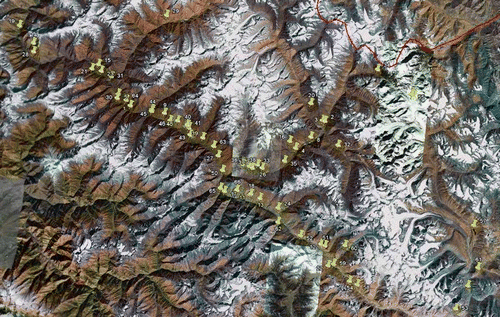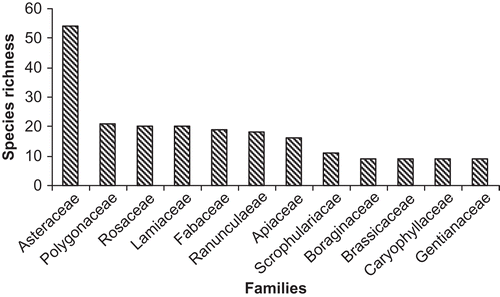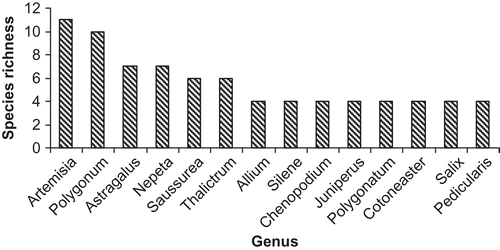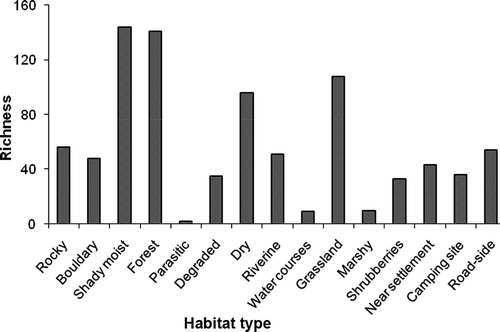Abstract
The Cold Desert of India is known for specific topography, severe climate and unique vegetation. The Lahaul valley in Himachal Pradesh, part of a proposed Cold Desert Biosphere Reserve, is rich in medicinal plants, and local people practice the Tibetan System of Medicine. A few studies are available on medicinal plants there are no integrated studies. A total of 354 medicinal plants, belonging to 208 genera and 76 families were recorded. The area ranges in altitude between 2801–3800 m, and shady moist and forested habitats were identified as having the most medicinal plant species. The occurrence of near endemic, endemic, critically endangered, endangered, vulnerable and near threatened species indicates high anthropogenic pressure and that the area has high conservation value. Most of these species are commercially viable. An assessment of populations of threatened species using standard ecological methods, and notification of key areas as medicinal plants conservation areas is suggested. Also, mass reproduction for ex situ conservation and to ensure availability of quality planting material for cultivation, together with education and awareness programmes for large-scale cultivation are suggested.
Introduction
The Himalayan region has been identified as a biodiversity hot spot (Myers et al. Citation2000). The use of plants as medicines for treatment of various diseases has occurred since time immemorial. Among the biogeographic provinces of India, the Indian Himalayan Region (IHR) is well known for its diversity of medicinal plants. There are 1748 medicinal plants that have traditional and modern therapeutic uses (Samant et al. Citation1998). The region is mostly inhabited by rural and native communities. Tribal cultures hold much ethnobotanical information, and rural and native communities regularly use medicinal plants for treatment of diseases, wounds, fractures and other ailments (Samant et al. Citation1998; Samant and Palni Citation2000). People living in the harsh environmental conditions of cold deserts in the IHR have evolved unique traditions and customs that include ethnobotanical dependence. The Larjee/Amchi people of the area usually practice the Tibetan System of Medicine for treatment of various ailments.
A large number of studies have been carried out on medicinal plants of the IHR (Jain Citation1991; Samant et al. Citation1998, Citation2001, Citation2007b; Rai et al. Citation2000; Samant and Pal Citation2003; Kala Citation2006). However, in Himachal Pradesh studies of medicinal plants are fragmentary and mainly focus on inventory (Bhattacharya and Uniyal Citation1982; Chauhan Citation1988, Citation1999; Kapahi Citation1990; Badola Citation2001; Sood et al. Citation2001; Badola and Pal Citation2003; Kala Citation2003, Citation2006), although a few studies have addressed diversity, distribution patterns, nativity, endemism, rarity and conservation prioritization of medicinal plants (Samant et al. Citation2007a, b). Himachal Pradesh has 643 medicinal plants, out of which 269 are native, 374 non-native, 17 endemic, 131 near endemic, 12 critically endangered, 21 endangered, 27 vulnerable, two near threatened and three data deficient (Samant et al. Citation2007a).
The Cold Desert Biosphere Reserve is a proposed reserve in the IHR, with an approximate area of 74,809 km2. It includes parts of Ladakh district in Jammu and Kashmir, and Lahaul and Spiti districts in Himachal Pradesh. The cold desert covers 35% of the area of Himachal Pradesh. A review of the literature indicates very few studies on ethnobotany and medicinal plants from the Lahaul valley of the proposed Cold Desert Biosphere Reserve (Aswal and Mehrotra Citation1987; Chauhan Citation1999; Sood et al. Citation2001; Bahar Citation2002; Kala Citation2003, Citation2006). To date, there have been no studies integrating (i) diversity and distribution patterns of medicinal plants; (ii) indigenous uses; (iii) status and distribution patterns of native and endemic medicinal plants; (iv) threat assessment to the diversity of medicinal plants; and (v) prioritization of medicinal plants for conservation. This paper seeks to remedy these deficiencies.
Study area
The Lahaul valley (31° 44′ 57”–32° 59′ 57”N, 76° 46′ 29”– 78° 41′ 34”E; total area: 6244 km2) is part of the proposed Cold Desert Biosphere Reserve. The altitude ranges from 2400 to 6517 m, asl. The mountains are largely composed of ancient Lurian rocks, chiefly schists, slate, shale, Balaini conglomerates and sandstone (Singh et al. Citation1995). The area is divided into four valleys: Mayar, Chandra, Bhaga and Chandra-Bhaga. Climate varies from dry temperate to alpine. The area receives heavy snowfall (120–400 cm year− 1) during winter and limited rainfall (10–300 mm year− 1) in summer. Temperature ranges from − 19°C to 32°C (Sinha and Samant Citation2006). The vegetation is mainly of temperate, sub-alpine and alpine types. The valley is surrounded by high mountains with an average height of 5480 m: the highest peak, Mulkila, reaches 6517 m, and the lowest point (2400 m) lies at the entrance to Chenab in the Pangi valley. The inhabitants of the area are Hindu, Buddhist or mixture of the two. They are largely dependent on local biodiversity for their subsistence.
Methods
Surveys, sampling, data collection and analysis
The inhabitants of 66 villages in Mayar, Chandra, Bhaga and Chandra-Bhaga valleys were selected and sampled from 2004 to 2008 to generate information on indigenous uses of medicinal plants by the inhabitants (). Information on medicinal plants was collected through a participatory rural appraisal (PRA) (Samant et al. Citation2003). Before PRA, the villages were visited two or three times to confirm that they were willing to exchange information. After these interactions, a meeting was convened and inhabitants were interviewed with regard to their utilization of medicinal plants. They were asked about the indigenous uses of medicinal plants, modes of administration and occurrence in the area. Local dialects as well as Hindi were used for effective conversations.
The age of respondents ranged from 25 to 65 years. Those older than 50 years had a rich knowledge base. Among the inhabitants, one person was hired for the survey and collection of medicinal plants from the natural habitat(s) and to provide information on local names, altitudinal range, life forms, habitat(s), part(s) used and use values, including indigenous knowledge and practices. Habitats were identified based on physical features. While most of the species were identified on site, samples of a few species were brought to the G.B. Pant Institute and identified with the help of floras (Polunin and Stainton Citation1984; Aswal and Mehrotra Citation1994; Dhaliwal and Sharma Citation1999; Murti Citation2001). Species known to have medicinal value from the literature, but not currently utilized by the tribal communities were also listed (Jain Citation1991; Aswal and Mehrotra Citation1994; Samant et al. Citation1998, 2001). The information was compiled and analysed with respect to utilization patterns following Samant et al. (Citation2002): for external use, the plant part is crushed and converted into a paste, which is applied to the affected part; for internal use, the plant part is eaten raw, made into a paste and eaten, or prepared as a decoction (half glass or full glass with water depending upon the condition of patient) and given to the patient.
Identification of nativity, endemism, threat category and prioritization for conservation
The nativity of species denotes the first record or origin, following Anonymous (Citation1883–1970) and Samant et al. (Citation1998). Endemism of a species was identified based on distribution range of the species and following Dhar and Samant (Citation1993) and Samant et al. (Citation1998). Species restricted to the IHR were considered as endemic, and those with a distribution extending to neighbouring countries (Himalayan regions of Afghanistan, Pakistan, Tibet, Nepal, Bhutan and adjacent states of the IHR) were considered as near endemics. The threat category of a species was identified using six attributes (i.e. habitat preference, distribution range, population size, use pattern, extraction trend, native and endemic species) and following Samant et al. (Citation1998) and Ved et al. (Citation2003). Species with a combination of these criteria (serial number 1, 2 and 3) were given marks accordingly. Species with scores >60 were identified as critically endangered; 56–60 as endangered; 51–55 as vulnerable; 46–50 as near threatened; and <46 as of least concern ().
Table 1. Threat assessment of the medicinal plant diversity using different criteria
Results
Diversity and distribution patterns
In total, 354 species of medicinal plants belonging to 208 genera and 76 families were recorded. Of these, 27 species were trees, 40 shrubs, 284 herbs and 3 ferns. The families Asteraceae (54 spp.), Polygonaceae (21 spp.), Rosaceae and Lamiaceae (20 spp. each), Fabaceae (19 spp.), Ranunculaceae (18 spp.) and Apiaceae (16 spp.) (); and genera Artemisia (11), Polygonum (10), Astragalus and Nepeta (7 each) and Saussurea and Thalictrum (6 each), were rich in medicinal plants (). A total of 31 families were monotypic ().
Table 2. Diversity, distribution and indigenous uses of medicinal plants of Lahaul valley of the proposed CDBR
In terms of altitudinal distribution, the greatest number (337 spp.) of medicinal plants was recorded from 2801–3800 m, followed by the 2400–2800 m zone (176 spp.), with the lowest number (90 spp.) in the >3801 m altitudinal zone. The habitat-wise distribution showed maximum diversity of medicinal plants (144 spp.) in shady moist habitats, followed by forest (141 spp.), grassland (108 spp.), dry (96 spp.) and rocky (56 spp.) habitats ().
Utilization pattern
Different parts of plants – leaves (107 spp.), aerial part (97 spp.), whole plants (96 spp.), roots (93 spp.), inflorescences (48 spp.), fruits (33 spp.), seeds (29 spp.), twigs (16 spp.), bark (9 spp.), tubers (6 spp.), rhizomes, bulbs, gum/latex (4 spp., each), fronds (2 spp.), ash from twigs (1 spp.) – were used by the tribal communities for their own use or in trade (). Of the 354 species of medicinal plant recorded, indigenous uses of 230 species were recorded from information collected from tribal communities and documented for the first time. The indigenous uses of 124 species were based on secondary information. A total of 196 common species was reported. Amongst the medicinal plants, Aconitum heterophyllum, A. violaceum, Angelica glauca, Allium carolianum, A. victorialis, Arnebia euchroma, Betula utilis, Bergenia stracheyi, Bunium persicum, Carum carvi, Corylus jacquemontii, Dactylorhiza hatagirea, Dioscorea deltoidea, Ephedra gerardiana, Gentianella moorcroftiana, Hippophae rhamnoides, H. salicifolia, Hypericum perforatum, Hyssopus officinalis, Hyoscyamus niger, Inula racemosa, Juglans regia, Juniperus polycarpos, Jurinella macrocephala, Podophyllum hexandrum, Picrorhiza kurrooa, Rheum australe, R. webbianum, Rhododendron anthopogon, Saussurea costus, S. gossypiphora and Taraxacum officinale were most preferred for indigenous use and trade purposes.
Nativity and endemism
Of the total species recorded, 146 were native to the Himalayan region. These included 126 near-endemic species and seven species endemic to the IHR (Angelica glauca, Heracleum thomsonii, Saussurea costus, Berberis pseudumbellata, Codonopsis clematidea, Corydalis vaginans and Lagotis cashmeriana) (). The remaining 208 species were non-native, from different biogeographic domains of the world ().
Threat categorization and conservation prioritization
Thirteen species were identified as critically endangered, 27 as endangered, 40 as vulnerable, 81 species as near threatened and 193 as of least concern (). The species identified as critically endangered, endangered and vulnerable have been prioritized for conservation. Of these species, 68 face habitat degradation, 10 over-exploitation and 81 both habitat degradation and over-exploitation. Amongst the prioritized species for conservation, critically endangered, endangered and vulnerable categories species – Aconitum heterophyllum, A. violaceum, Angelica glauca, Allium humile, A. victorialis, Dactylorhiza hatagirea, Dioscorea deltoidea, Hippophae rhamnoides, H. salicifolia, Hypericum perforatum, Hyoscyamus niger, Jurinella macrocephala, Ephedra gerardiana, Podophyllum hexandrum, Picrorhiza kurrooa, Rheum australe, R. webbianum – and some of near threatened species – Bunium persicum, Carum carvi and the cultivated species Inula racemosa, Saussurea costus were recommended for commercial cultivation in the Lahaul valley based on their market potential (; own criteria).
Table 3. Status of recorded species under threat in Lahaul valley and comparison to other places
Discussion and conclusions
The IHR is well known for its diversity of medicinal plants (Jain Citation1991; Samant et al. Citation1998, 2001, 2007a, b). However, studies on medicinal plants at catchment, watershed and valley levels are not available, although these are the prerequisites for the developmental planning of such geographical entities. The present study provides a comprehensive database that provides baseline information for developing management plans for the conservation of medicinal plant diversity in Lahaul valley of the proposed Cold Desert Biosphere Reserve, in particular, and cold deserts of the IHR in general.
The occurrence of 354 species of medicinal plants in the area indicates that its environmental conditions, particularly shady moist and forest habitats, are suitable for the growth and development of such species. These habitats require regular monitoring to understand the dynamics of the vegetation. The altitudinal range 2801–3800 m has the most medicinal plant species. The occurrence of 41.4% of native species, 35.7% of near endemic species and 2.0% of endemic species shows the high conservation value of the area. Habitat degradation and over-exploitation of these species may lead to their early extinction in this area. The over-exploitation of both whole medicinal plants and plant parts – roots, rhizomes, tubers, inflorescences, fruits and seeds – may lead to poor regeneration and extirpation of these plants.
An area-specific threat categorization of species is very important for short- or long-term management planning. The present study represents such an attempt in this area, using information on different attributes. The occurrence of critically endangered, endangered and vulnerable medicinal plants indicates high anthropogenic pressure on these species. If over-exploitation and habitat degradation of these species continues, they may disappear from the area within a few years. Population assessment of these species using standard ecological methods and notification of key areas as medicinal plants conservation areas (MPCAs) for in situ conservation, with the involvement of the Forest Department and tribal communities, are suggested. In addition, mass reproduction using conventional (vegetative and seeds) methods, establishment and maintenance of herbal gardens and medicinal plants nurseries for ex situ conservation and ensuring the availability of quality planting material for cultivation, together with education and awareness programmes for large-scale cultivation are suggested.
Acknowledgement
The authors thank Dr. L.M.S. Palni, Director of the Institute, for providing necessary facilities and encouragement. The inhabitants of the Lahaul valley are acknowledged for providing information during the surveys. All research scholars of the Biodiversity Conservation and Management Theme of GBPIHED, Himachal Unit, Mohal-Kullu, are acknowledged for their support. The Ministry of Environment and Forests, Government of India, New Delhi, is also acknowledged for financial support.
References
- Anonymous . 1883–1970 . Index Kewensis plantarum phanerogamarum Vol. 1–2 (1883–1885) and 15 Suppl. (1886–1970) , Oxford : Clarendon Press .
- Aswal , BS and Mehrotra , BN . 1987 . “ Ethnobotanical studies on the flora of Lahaul valley (North-West Himalaya) ” . In Recent advances in plant sciences , Edited by: Sharma , MR and Gupta , BK . 116 – 130 . Dehradun, , India : Bishen Singh and Mahendra Pal Singh . editors
- Aswal , BS and Mehrotra , BN . 1994 . Flora of Lahaul-Spiti (a cold desert in North-West Himalaya) , Dehradun, , India : Bishen Singh and Mahendra Pal Singh .
- Badola , HK . 2001 . “ Medicinal plant diversity of Himachal Pradesh ” . In Himalayan medicinal plants: potential and prospects, Occasional Publication No. 14 , Edited by: Samant , SS , Dhar , U and Palni , LMS . 87 – 116 . Nainital, , India : Gyanodaya Prakashan . editors
- Badola , HK and Pal , M . 2003 . Threatened medicinal plants and their conservation in Himachal Himalaya . Indian For. , 129 : 55 – 68 .
- Bahar , N . 2002 . Some medicinal plants of cold desert . Indian For , 128 ( 4 ) : 465 – 469 .
- Bhattacharya , UC and Uniyal , BP . 1982 . A botanical tour to Pangi and Trilokinath in upper Chenab . J Bombay Nat Hist Soc India. , 79 : 57 – 78 .
- Chauhan , NS . 1988 . “ Endangered Ayurvedic pharmacopoeial plant resources of H.P ” . In Indigenous medicinal plants , Edited by: Kaushik , P . 187 – 198 . New Delhi, , India : Today and Tomorrows Printers and Publishers .
- Chauhan , NS . 1999 . Medicinal and aromatic plants of Himachal Pradesh , New Dehli, , India : Indus Publishing Company .
- Dhar , U and Samant , SS . 1993 . Endemic diversity of Indian Himalaya. I. Ranunculaceae and II. Paeoniaceae . J Biogeogr. , 20 : 659 – 668 .
- Dhaliwal , DS and Sharma , M . 1999 . Flora of Kullu District (Himachal Pradesh) , Dehra Dun, , India : Bishen Singh Mahendra Pal Singh .
- Jain , SK . 1991 . Dictionary of Indian folk medicine and ethnobotany , New Delhi, , India : Deep Publications .
- Kala , CP . 2003 . Medicinal plants of Indian Trans-Himalaya , Dehradun, , India : Bishen Singh Mahendra Pal Singh .
- Kala , CP . 2006 . Medicinal plants of the high altitude cold desert in India: diversity, distribution and traditional uses. Int . J Biodivers Sci Manage. , 2 ( 1 ) : 43 – 56 .
- Kapahi , BK . 1990 . Ethnobotanical investigations in Lahaul (Himachal Pradesh) . J Econ Tax Bot. , 4 ( 1 ) : 49 – 55 .
- Myers , N , Muttermeier , RA , Muttermeier , CA , Da Fonseca , ABG and Kent , J . 2000 . Biodiversity hotspots for conservation priorities . Nature. , 403 : 853 – 858 .
- Murti , SK . 2001 . Flora of cold deserts of Western Himalaya , Vol. I , Calcutta : Botanical Survey of India .
- Polunin , O and Stainton , A . 1984 . Flowers of the Himalaya , Oxford : Oxford University Press .
- Rai , LK , Prasad , P and Sharma , E . 2000 . Conservation threats to some important medicinal plants of the Sikkim Himalaya . Biol Conserv. , 93 : 27 – 33 .
- Samant , SS , Butola , JS and Sharma , A . 2007b . Assessment of diversity, distribution, conservation status and preparation of management plan for medicinal plants in the catchment area of Parbati Hydroelectric Project Stage – III in Northwestern Himalaya . J Mt Sci. , 4 ( 1 ) : 34 – 56 .
- Samant , SS , Dhar , U and Palni , LMS . 1998 . Medicinal plants of Indian Himalaya: diversity distribution potential values , Nainital, , India : Gyanodaya Prakashan .
- Samant , SS , Dhar , U and Palni , LMS . 2001 . Himalayan medicinal plants: potential and prospects , Nainital, , India : Gyanodaya Prakashan .
- Samant , SS , Joshi , HC , Arya , SC and Pant , S . Studies on the structure, composition and changes of the vegetation in Nanda Devi Biosphere Reserve of West Himalaya . Final Technical Report submitted to Ministry of Environment and Forests; New Delhi, India . 2002 .
- Samant , SS , Joshi , HC , Arya , SC and Pant , S . 2003 . Planning for the conservation and management of natural resources using participatory approach: a case study from Pindari area of Nanda Devi Biosphere Reserve, West Himalaya, India . Van Vigyan. , 38 ( 1–4 ) : 41 – 54 .
- Samant , SS and Pal , M . 2003 . Diversity and conservation status of medicinal plants in Uttaranchal State . Indian For. , 129 ( 9 ) : 1090 – 1108 .
- Samant , SS and Palni , LMS . 2000 . Diversity, distribution and indigenous uses of essential oil yielding plants of Indian Himalayan Region . J Med Aromatic Plant Sci. , 22 : 671 – 684 .
- Samant , SS , Pant , S , Singh , M , Lal , M , Singh , A , Sharma , A and Bhandari , S . 2007a . Diversity, distribution pattern, indigenous uses and conservation prioritization of medicinal plants of Himachal Pradesh, India . Int J Biodivers Sci Manage. , 3 : 234 – 251 .
- Singh , RP , Bahar , N and Negi , DV . 1995 . Impact of grazing on soil erosion in forest ecosystems . Indian For. , 121 ( 8 ) : 717 – 719 .
- Sinha , SK and Samant , SS . 2006 . Climate change in the higher Himalayas – a case study in Lahaul valley . ENVIS News letter. Himalayan Ecol. , 3
- Sood , SK , Nath , R and Kalia , DC . 2001 . Ethnobotany of cold desert tribes of Lahaul–Spiti (North West Himalaya) , India : Deep Publications .
- Ved , DK , Kinhal , GA , Ravikumar , K , Prabhakaran , V , Ghate , U , Vijaya Shankar , R and Indresha , JH . 2003 . Conservation assessment and management prioritization for the medicinal plants of Jammu & Kashmir, Himachal Pradesh & Uttaranchal , Bangalore, , India : Foundation for Revitalization of Local Health Traditions .



